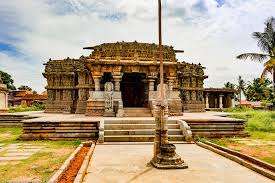Javagal Lakshminarasimha Temple, Karnataka

Address
Javagal Lakshminarasimha Temple Javagal, Hassam District, Karnataka 573125
Diety
Lakshminarasimha
Introduction
The Lakshminarasimha Temple at Javagal, also known as the Lakshmi Narasimha Temple of Javagallu, is a remarkable 13th-century temple characterized by Hoysala architecture. Located in Javagal, Karnataka, India, this temple is dedicated to Lord Narasimha, the man-lion avatar of Lord Vishnu. It was commissioned by King Vira Someshwara of the Hoysala Empire and is known for its exquisite artistry and intricate carvings.
Location: The temple is situated in Javagal, about 20 kilometers northeast of Halebidu and approximately 50 kilometers from Hassan city in Karnataka, India.
Architectural Style: The temple exemplifies the distinctive Hoysala architectural style, which was prominent during the Hoysala Empire. This style is characterized by intricate stone carvings and ornate temple structures.
Dedication: The Lakshminarasimha Temple is a triple shrine temple with three sanctums. These sanctums are dedicated to Lakshminarasimha, Sridhara, and Venugopala, representing different forms of Lord Vishnu.
Artwork: The temple is renowned for its lavish artwork and boasts over 100 intricately carved panels both on the exterior and interior. Many of these panels depict scenes and legends from the Ramayana, making it a treasure trove of artistic representations.
Historical Significance: The foundation stone and inscriptions that could directly date the temple’s construction are missing. However, the temple’s date can be inferred from the signatures carved into some of the panels. These signatures include those of the celebrated 13th-century sculptor Mallitamma, known for his exquisite work. This evidence suggests that the temple was likely completed by around 1260 CE.
Architectural Plan: The temple follows a square architectural plan, which is typical of Hoysala temples. It is a trikuta temple, consisting of three equally sized shrines. The middle shrine features a superstructure (tower) and a sukhanasi (a tower-like structure over the vestibule).
Design Elements: The temple’s lower part has five projections per side, with the central shrine having these projections visible on three sides, while the lateral shrines show them on only one side. This design gives the impression of a single shrine with bulging walls when viewed from the outside.
Ornate Features: The temple includes a raised platform (jagati), a common feature in Hoysala temples, which serves both a visual and circumambulatory purpose. The central shrine’s tower, vestibule, and decorative elements are well-preserved and highly intricate. These elements include a domed roof, kalasa (decorative water pot), and the Hoysala crest, although the emblem and kalasa are missing.
Despite the missing elements and later modifications, the Lakshminarasimha Temple at Javagal remains a testament to the architectural and artistic brilliance of the Hoysala dynasty and continues to attract admirers and devotees from around the world.
Century/Period/Age
1250–1260 A.D
Managed By
Archaeological Survey of India.
Nearest Bus Station
Javagal
Nearest Railway Station
Banavar
Nearest Airport
Bangalore




